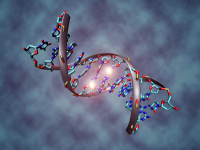 NEWS
NEWS
The Blueprint project celebrates major manuscript release
BLUEPRINT scientists, including researchers at the Centre for Genomic Regulation, release a collection of 25 publications in Cell, Cell Press-associated and other high-impact journals. These are part of a package of 41 publications by the International Human Epigenome Consortium (IHEC) of which BLUEPRINT is a member.
One of the great mysteries in biology is how the many different cell types that make up our bodies are derived from a single cell and from one DNA sequence, or genome. We have learned a lot from studying the human genome, but have only partially unveiled the processes underlying cell determination. The identity of each cell type is largely defined by an instructive layer of molecular annotations on top of the genome – the epigenome – which acts as a blueprint unique to each cell type and developmental stage. Unlike the genome the epigenome changes as cells develop and in response to changes in the environment. Defects in the factors that read, write and erase the epigenetic blueprint are involved in many diseases. The comprehensive analysis of the epigenomes of healthy and abnormal cells will facilitate new ways to diagnose and treat various diseases, and ultimately lead to improved health outcomes.
A collection of 42 coordinated papers now published by scientists from across the International Human Epigenome Consortium (IHEC) sheds light on these processes, taking global research in the field of epigenomics a major step forward. A set of 24 manuscripts has been released as a package in Cell and Cell Press-associated journals, and an additional 17 papers have been published in other high-impact journals.
These papers represent the most recent work of IHEC member projects from Canada, the European Union, Japan, Singapore, South Korea, and the United States. The collection of publications showcases the achievements and scientific progress made by IHEC in core areas of current epigenetic investigations.
“All these results in the framework of the Blueprint project and the International Human Epigenome Consortium definitively contribute to fill the gaps we still have from genomic data. We have made a lot of progress since we started analyzing the first human genome but there still are many questions to solve. Blueprint will now offer amazing data related to cellular mechanisms, which may be linked to many human diseases”, said Professor Roderic Guigó, group leader at the Centre for Genomic Regulation (CRG) in Barcelona and one of the principal investigators of the EU-funded BLUEPRINT project.
In a Nutshell: Key Findings from the Collection of Papers
Key research findings presented in the collection can be collated into four broad categories with a first group of papers presenting a series of molecular and computational approaches to deconvolute distinct epigenomic signatures from tissues that contain a mix of different cell types. Researchers at the CRG led by Roderic Guigó contributed to one of the papers in this group. In particular, they participated in a paper aimed at mapping quantitative trait loci (QTL) in three different cell types from the immune system. CRG researchers used a method which was developed by Guigó and collaborators to identify QTLs in epigenetics and in a particular process called splicing. Their results contribute to get an expansive, high-resolution atlas of multi-omics changes in three major human immune cell types.
A second group of publications highlights BLUEPRINT’s significant efforts and investments to develop new computational tools for the access, distribution and sharing of epigenomic data via various channels to the community, thus upholding the European Commission’s pledge to maximise open access to its funded research.
In a third category, datasets produced by BLUEPRINT members were used to investigate molecular mechanisms underlying different cellular processes in normal and abnormal cell development. These analyses may in future help doctors to target the right treatments to the right patients.
A fourth group of papers in the collection uses epigenomic information to characterize how nuclear organization and genetic variants affect the expression of genes, and how these genes in turn contribute to disease.
“BLUEPRINT has produced more new science and more understanding of blood cell disease than we could have imagined at the outset. We have made the data of >1000 datasets publicly available” says Professor Hendrik (Henk) Stunnenberg from Radboud University, The Netherlands, former Chair of the IHEC International Scientific Steering Committee and coordinator of the EU-funded BLUEPRINT project. “Moreover, we have forged an alliance of researchers and innovative companies from around Europe and, working closely with international partners, we already see results that, in time, will improve the lives of patients.”
Reference
The full collection of IHEC papers is available here.
About BLUEPRINT
The project BLUEPRINT – A BLUEPRINT of Haematopoietic Epigenomes is a large-scale research project receiving close to 30 million euro funding from the EU. 42 leading European universities, research institutes and industry entrepreneurs participate in what is one of the two first so-called high impact research initiatives to receive funding from the EU.
About IHEC
The International Human Epigenome Consortium (IHEC) is a global consortium with the primary goal of providing free access to high-resolution reference human epigenome maps for normal and disease cell types to the research community. IHEC members support related projects to improve epigenomic technologies, investigate epigenetic regulation in disease processes, and explore broader gene-environment interactions in human health. Current full members of IHEC include: AMED-CREST/IHEC Team Japan; DLR-PT for BMBF German Epigenome Programme DEEP; CIHR Canadian Epigenetics Environment, and Health Research Consortium (CEEHRC); European Union FP7 BLUEPRINT Project; Hong Kong Epigenomics Project; KNIH Korea Epigenome Project; the NIH/NHGRI ENCODE Project; the NIH Roadmap Epigenomics Program; and the Singapore Epigenome Project.
| Attachment | Size |
|---|---|
| 842.15 KB | |
| 844.82 KB | |
| 845.09 KB |

